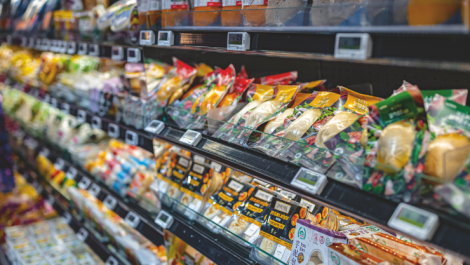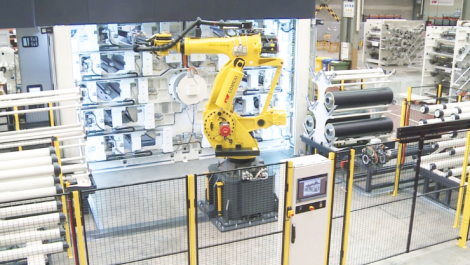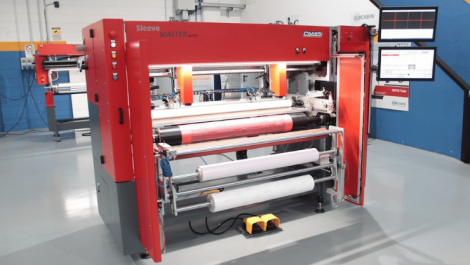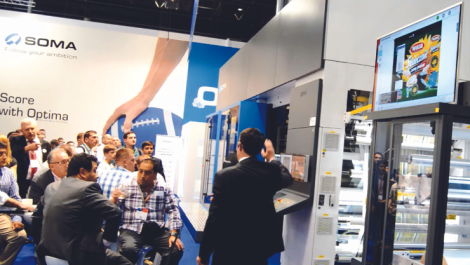CPI’s Eric Gat explained the plasma treatment process to seminar delegates
The cooperative partnership between corona treatment pioneers, Vetaphone, and EASI-Plasma specialists, Coating Plasma Industrie (CPI), was taken a stage further recently with an educational seminar at the French company’s headquarters near Aix-en-Provence. Nick Coombes reports.
CPI was established in 2001 as a cold plasma surface treatment manufacturer, and, for the past 14 years has supplied technology to companies in the print, packaging, textile, polymer and metal industries. It offers two types of plasma treatment, atmospheric and low pressure, and designs, builds, tests and integrates its technology at its factory in Peynier. As a partner for the company that invented corona treatment, the match could scarcely be better, with a combined fount of knowledge that far exceeds what any other supplier can offer. And with Vetaphone’s international sales and service coverage, the prospects look promising.
Controlling the atmosphere
Frank Eisby, Vetaphone’s managing director welcomed packaging specialists from some of the world’s leading brand owners, and introduced project manager Kim Bredgaard, who set about explaining the difference between the two surface treatments. ‘The principle difference between corona and plasma is a matter of control. Corona applies energy in an uncontrolled atmosphere, plasma in a controlled one. Both separate the atoms and molecules, but corona creates uncontrolled molecular bonds on the surface and ozone in the atmosphere, while plasma grafts controlled molecular bonds onto the surface, with no ozone creation at all,’ he said. He then explained the science behind both processes, which involves nitrogen, oxygen, carbon and hydrogen in corona, but only nitrogen, oxygen and carbon in plasma, which imbues the latter with six different applications: adhesion, anti-ageing, anti-fogging, hydrophobic ability, release and hydrophilic ability.
Ronni Nielsen, also a project manager at Vetaphone, continued the presentation by explaining how the use of UV and water-based inks on BOPP had always caused problems for corona, which had a peak level of 46 dyn/cm, whereas standard EASI-Plasma could increase this to 56 dyn/cm, and to 60 dyn/cm with Advanced EASI-Plasma.
Eric Gat, of CPI then highlighted two case studies. The first involved EASI-Plasma Advanced Grafting for the use of UV flexo ink on food packaging, where high cost, high energy consumption, and poor environmental impact was reflecting badly on the existing corona treatment with chemical primer. ‘By switching to EASI-Plasma, a more eco-friendly solution was found that was solvent-free, and met food industry standards – it also offered excellent ink adhesion on the BOPP substrate,’ he explained.
The second case study involved multiplex film, where the customer needed to hot laminate PE onto BOPET and achieve good adhesion, and was using a chemical primer that was costly and available from only one supplier. ‘We convinced the customer to use EASI-Plasma for roll-to-roll grafting of PET, which was cheaper and allowed him to use standard BOPET film – the solution offered excellent adhesion, and removed the adhesive and solvent, and the need for curing,’ said Mr Gat.
Prolonging shelf life
The next section looked at anti-ageing, or the prolonging of shelf life. Mr Nielsen explained that not only were higher dyne levels attainable with EASI-Plasma than with corona treatment, but that the level was maintained for a longer period. Using standard BOPP as an example, he said, ‘Under normal circumstances, this film needs to be used within six months of delivery and in strict stock rotation. With EASI-Plasma Advanced Grafting, we can achieve and sustain 60 dyn/cm.’ Mr Gat highlighted case study 3 in which irregularities in performance were appearing with BOPP film after three months in stock. ‘The client needed a longer shelf life for the substrate, and reliable performance from it – with EASI-Plasma we can guarantee a minimum dyne level of 56 for at least 18 months, without the need for boost treatment prior to converting,’ he explained.
Mr Bredgaard said that anti-fogging is high on the list of priorities for the agriculture and horticulture industries. ‘Without anti-fog treatment small water droplets build up on the clear film and inhibit the growth of the plant and ripening of the fruit. Using additives, the droplets become larger, but these also pose a problem by focusing light. EASI-Plasma anti-fogging allows a thin layer of water to drain away without dripping, and allow maximum light transmission with minimal plant damage.’
Case study 4 looked at the requirements of a market garden business that grows food in greenhouses. According to Mr Gat, the need was for anti-fogging on PP, PE, and PET films, which when achieved with adhesives created a number of problems, including poor print quality, discolouration, odour taint, and soil contamination. ‘With EASI-Plasma silica nano-coating, we achieved a very high surface energy that solved the printing and ecological problems. The new solution meant the film was not heat-sealable, but could be sealed ultrasonically.’
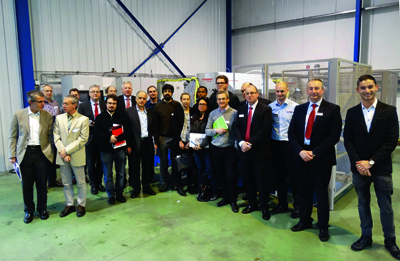
Leading packaging specialists from global brand owners attended the one-day event at CPI’s headquarters in France
Water repellence is a key feature in many industries and across a variety of materials, from metal to plastic, paper, and textiles. Hydrophobic performance is therefore of great value, and while traditional coating methods lead to problems with layer thickness, lack of uniformity, drying/curing, and a general lack of control on single-sided treatment (transfer), with EASI-Plasma, monomers interact at the surface and build a chemical network to form a coating that is 100 times thinner than with traditional methods. The case study showed tickets being printed on PET using a silicone liquid chemical topcoat. This had the disadvantages of high cost, an adverse environmental impact, and contamination by transfer. CPI used its test facilities to show that EASI-Plasma silicone nano-coating, run roll to roll on 1.2 metre wide PET film, could achieve low surface energy (30 dyn/cm), with no contaminant.
Conclusion
Looking ahead, Mr Gat talked about surface cleaning applications, where, for example, poor quality coating/printing performance that is the result of organic contamination on the conductive surface, can be overcome by EASI-Plasma treatment that controls the cleaning process by measuring surface energy. The process can also offer barrier properties, which prolong the shelf life of, for example, packaged food products. Polymers are permeable to gas because of their chain mobility, so a typical solution is to laminate the film, but this causes recycling problems and requires a complex and expensive material. EASI-Plasma’s alternative approach is to lay a thin inorganic barrier layer, which is cheaper and easy to recycle. Mr Gat also made a plea for a cooperative partner to test bio-fouling prevention using Atmospheric Pressure Plasma, which would offer significant benefits with its anti-bacterial qualities.
The delegates were left in no doubt of the advantages of plasma coating and the scope of its application across many industries. Concluding, Frank Eisby summarised, ‘EASI-Plasma offers much to many – from food packaging with anti-bacterial surfaces to prolonged storage of the world’s precious food resources and better logistics in supplying it, to new agricultural films that boost crop yields, reduce the need for environmentally damaging fertilisers, and thereby offer a healthier diet – and in the industrial markets, ultra thin barrier layers that provide protection from hazardous materials. We are only at the beginning of a momentous journey that can change the face of the world in which we live – what we need to do, is embrace it.’


